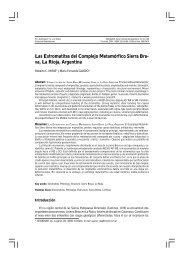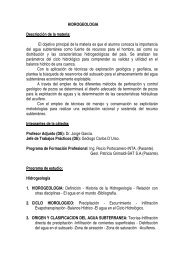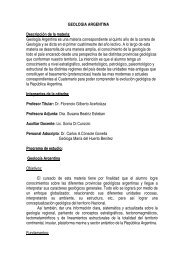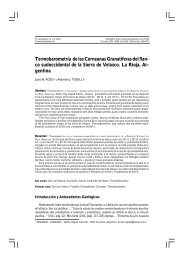Historia de la GeologÃÂa Argentina - INSUGEO
Historia de la GeologÃÂa Argentina - INSUGEO
Historia de la GeologÃÂa Argentina - INSUGEO
Create successful ePaper yourself
Turn your PDF publications into a flip-book with our unique Google optimized e-Paper software.
<strong>Historia</strong> <strong>de</strong> <strong>la</strong> Geología <strong>Argentina</strong><br />
<strong>INSUGEO</strong>, Misce<strong>la</strong>nea 16: xxx-xxx<br />
Tucumán, 2007 - ISSN 1514-4836 - ISSN 1668- 3242 on-line<br />
Aportes <strong>de</strong> Charles Darwin al Conocimiento <strong>de</strong> <strong>la</strong><br />
Geología Sudamericana<br />
José Mendía 1 y Eduardo O. Zappettini 1<br />
Las contribuciones <strong>de</strong> Darwin al conocimiento geológico <strong>de</strong> América <strong>de</strong>l Sur<br />
fueron registradas en cuatro publicaciones: On the connection of certain volcanic phenomena in<br />
South America (1838), On the distribution of erratic boul<strong>de</strong>rs and on the contemporaneous stratified<br />
<strong>de</strong>posits of South America (1841), An account of the fine dust which often falls on vessels in the<br />
At<strong>la</strong>ntic Ocean (1845) y, On the Geology of the Falk<strong>la</strong>nd Is<strong>la</strong>nds (1846), y finalmente en el libro<br />
Observations on South America (1846) reeditado en 1876 como parte <strong>de</strong>l libro Geological<br />
observations on the volcanic is<strong>la</strong>nds and parts of the South America visited during the voyage of<br />
H.M.S. Beagle. Por otra parte, un primer ensayo inédito <strong>de</strong> sus observaciones geológicas<br />
fue escrito durante su viaje en el H.M.S. Beagle, hacia 1834 y que tituló Reflection on reading<br />
my Geological notes. En este trabajo <strong>de</strong>sarrolló Darwin una teoría sobre <strong>la</strong> formación<br />
geológica <strong>de</strong> América <strong>de</strong>l Sur e incluyó sus interpretaciones sobre <strong>la</strong> historia <strong>de</strong> <strong>la</strong> vida en<br />
el continente, que si bien no es evolucionista, es secuencial (cf. S. Herbert, 1995).<br />
Sus observaciones geológicas en América <strong>de</strong>l Sur cubren variedad <strong>de</strong> aspectos<br />
y, bajo <strong>la</strong> fuerte influencia <strong>de</strong> Lyell, incluyen el <strong>de</strong>sarrollo <strong>de</strong> hipótesis geológicas basadas<br />
en <strong>la</strong>s premisas <strong>de</strong>l levantamiento continental y <strong>la</strong> subsi<strong>de</strong>ncia <strong>de</strong> los océanos. Abundan<br />
<strong>la</strong>s observaciones tendientes a <strong>de</strong>mostrar esas hipótesis, incluyendo numerosos perfiles y<br />
corre<strong>la</strong>ciones <strong>de</strong> terrazas fluviales, efectuadas a partir <strong>de</strong> minuciosas mediciones altimétricas.<br />
Entre sus numerosos aportes se pue<strong>de</strong>n mencionar <strong>la</strong> <strong>de</strong>scripción en <strong>de</strong>talle <strong>de</strong> <strong>la</strong> naturaleza<br />
y extensión <strong>de</strong> los Rodados Patagónicos, que <strong>de</strong>nomina “Gravel Formation of<br />
Patagonia”, formu<strong>la</strong>ndo una hipótesis respecto a su origen. Analiza <strong>la</strong> formación <strong>de</strong> los<br />
<strong>de</strong>pósitos salinos superficiales tanto en <strong>la</strong> región andina como en <strong>la</strong> región pampeana y<br />
patagónica, incluyendo consi<strong>de</strong>raciones sobre su composición y calidad.<br />
Respecto <strong>de</strong> <strong>la</strong>s formaciones <strong>de</strong> edad terciaria y cuaternaria <strong>de</strong> <strong>la</strong> región pampeana y <strong>de</strong><br />
<strong>la</strong> costa patagónica, analiza <strong>la</strong> constitución mineralógica, estructura microscópica y contenido<br />
fosilífero en una amplia región que abarca <strong>de</strong>s<strong>de</strong> Buenos Aires a San Julián.<br />
En 1862 publica un artículo, incluido en el libro <strong>de</strong> 1876, sobre el espesor <strong>de</strong> <strong>la</strong> Formación<br />
Pampeana cerca <strong>de</strong> Buenos Aires, en el que estudia y corre<strong>la</strong>ciona dos pozos artesianos<br />
hasta una profundidad <strong>de</strong> 80 metros.<br />
Describe <strong>la</strong>s formaciones terciarias <strong>de</strong> <strong>la</strong> región patagónica y su contenido<br />
fosilífero <strong>de</strong>s<strong>de</strong> Río Negro hasta Tierra <strong>de</strong>l Fuego, y su incursión por el río Santa Cruz<br />
le permite i<strong>de</strong>ntificar <strong>la</strong>s co<strong>la</strong>das basálticas <strong>de</strong>l curso medio y superior <strong>de</strong>l mismo.<br />
Respecto <strong>de</strong> <strong>la</strong>s formaciones mesozoicas y más antiguas se <strong>de</strong>stacan <strong>la</strong>s <strong>de</strong>scripciones <strong>de</strong><br />
<strong>la</strong>s sierras <strong>de</strong> Tandil y Ventana, y su comparación con <strong>la</strong>s unida<strong>de</strong>s aflorantes en Uruguay;<br />
1<br />
SEGEMAR; E-mail: jmendi@mecon.gov.ar


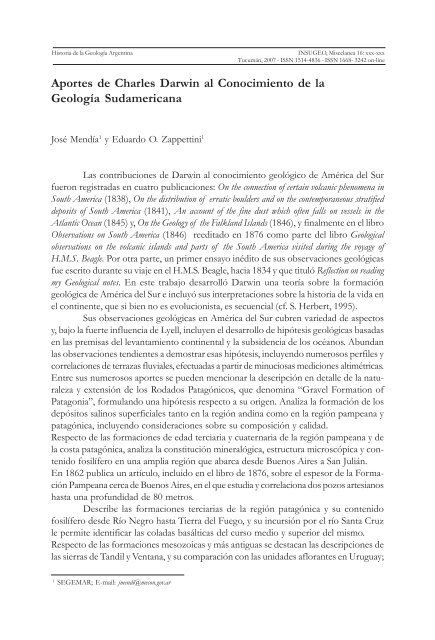
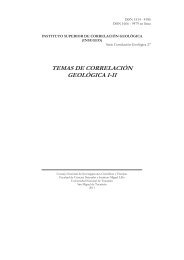
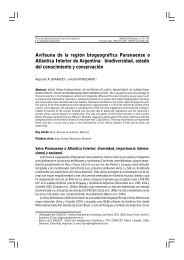

![Descargar El Libro Completo [5.631 Kb] - INSUGEO](https://img.yumpu.com/40710231/1/177x260/descargar-el-libro-completo-5631-kb-insugeo.jpg?quality=85)



